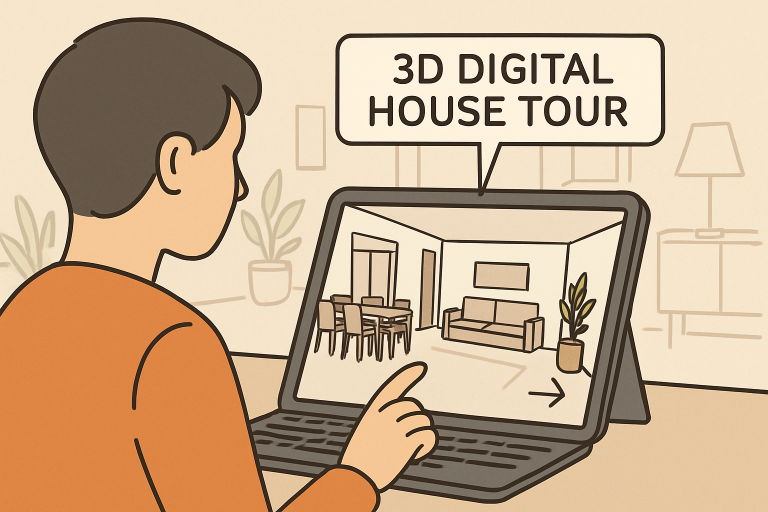Key Takeaways
- Digital home tours deliver immersive, interactive, 360-degree experiences, enabling buyers to evaluate homes remotely and efficiently.
- These tours save both buyers and sellers time and resources, reducing unnecessary in-person visits.
- Virtual home tours open up listings to local and international audiences, maximizing the seller’s market reach.
- Technological innovations, such as virtual staging and augmented reality, continue to enhance the home-buying journey.
In today’s digitally driven real estate market, the process of buying a home is evolving at an unprecedented rate. The advent of digital home tours is reshaping the way both buyers and sellers approach home transactions, delivering a level of convenience and immersion that traditional methods can’t match. For instance, potential homebuyers working with a Mandeville real estate agent Allison Vencil can now explore homes virtually—saving time, money, and energy while keeping the process efficient and accessible from anywhere in the world. These advancements are providing an opportunity for buyers to take control of their home search and for sellers to reach a broader pool of prospective clients, even outside their immediate region.
Virtual tours aren’t just about convenience—they’re about connection. They offer a richer, more engaging experience than static images or staged open houses. Buyers can virtually walk through rooms, assess finishing touches, and envision their lives within the space—all before setting foot on the property. This elevated approach to real estate is fast becoming the industry standard and is a crucial component for anyone navigating today’s real estate landscape.
Immersive Viewing Experience
With the latest advancements in digital media and 3D scanning, digital home tours provide a lifelike walkthrough of properties. Buyers can move from room to room, view the space from multiple angles, and zoom in on details that catch their eye—all in real time. This level of immersion creates a genuine sense of space and flow, allowing buyers to assess whether a property’s layout aligns with their lifestyle. The Times Union notes that these virtual walkthroughs are gradually replacing the first-stage in-person open houses, especially for time-sensitive or relocating buyers.
Time and Resource Efficiency
The traditional process of visiting multiple homes is inherently demanding—physically, emotionally, and financially. Digital tours streamline this experience by enabling potential buyers to shortlist their favorite properties from the comfort of their own homes, reducing travel and minimizing time off work. Buyers are empowered to pre-screen options online and focus only on homes that fit their criteria. This not only lowers transactional friction but also leads to more productive and informed physical showings—a benefit for both sellers and agents, as fewer but more qualified leads result in meaningful engagement and higher close rates. Agents and sellers leveraging this technology can focus on serious buyers, saving everyone time and resources.
Expanding Market Reach
The internet has no boundaries—and neither do digital home tours. Sellers can now connect with buyers both locally and globally, thereby expanding demand and competition for their listings. This is invaluable for buyers moving from distant cities or countries who need a reliable way to evaluate homes before committing to a visit. Virtual tours also make it easier to buy and sell homes in competitive markets, where properties sometimes sell before a buyer can feasibly visit in person.

Enhanced Decision-Making
Digital tours offer buyers increased access to property details, enabling them to make informed decisions. In-depth, virtual exploration allows home seekers to check everything from sunlight exposure to sightlines between rooms. Many platforms now include interactive floor plans and measurement tools, allowing buyers to envision furniture placement or explore renovation opportunities. These resources help buyers feel more confident about their shortlist, making for quicker and more confident offers once they’re ready to move forward. According to the National Association of Realtors data, today’s buyers are increasingly reliant on digital tools when forming opinions and making decisions about properties.
Technological Advancements
Virtual staging has become an integral part of digital home tours. Instead of physically decorating an empty listed property, sellers can now digitally place realistic furniture, art, or even paint schemes into their listings. This technology enables buyers to visualize the home’s full potential, regardless of its current condition. Augmented reality solutions take personalization even further, allowing users to overlay furniture or decor styles that suit their own tastes. These cutting-edge tools make it easy to imagine a house as a home and accelerate the decision-making process for buyers at every stage.
Building Emotional Connections
While static images can highlight a property’s features, digital tours foster powerful emotional connections. By simulating an in-person walk-through, buyers are better able to picture themselves going about their routines, celebrating milestones, or relaxing with family—even before they visit. These emotional connections often prompt buyers to move from browsing mode to action, transforming passive interest into genuine intent.
Competitive Advantage for Sellers
Properties featuring high-quality virtual tours and advanced visualization are more likely to stand out in crowded markets. These listings see increased engagement and, in many cases, shorter time on market. Integrating digital tours signals that a seller or agent is up-to-date with technological trends—an essential factor for tech-savvy millennials and Gen Z buyers. In turn, properties with immersive experiences often receive more inquiries and competitive offers.
Conclusion
The future of real estate is firmly rooted in digital innovation, with virtual home tours leading the way. These immersive experiences unlock unprecedented efficiency, reach, and satisfaction for both buyers and sellers. Adopting this technology is not simply about keeping up with the times—it’s about setting a new, higher standard for accessibility, transparency, and informed decision-making in the market.






